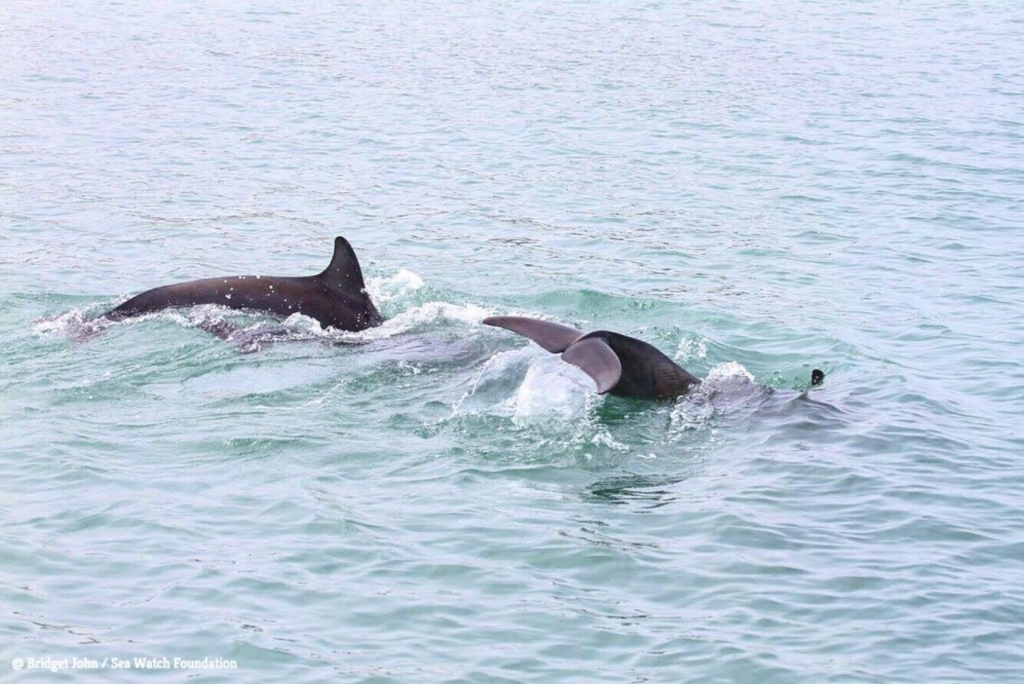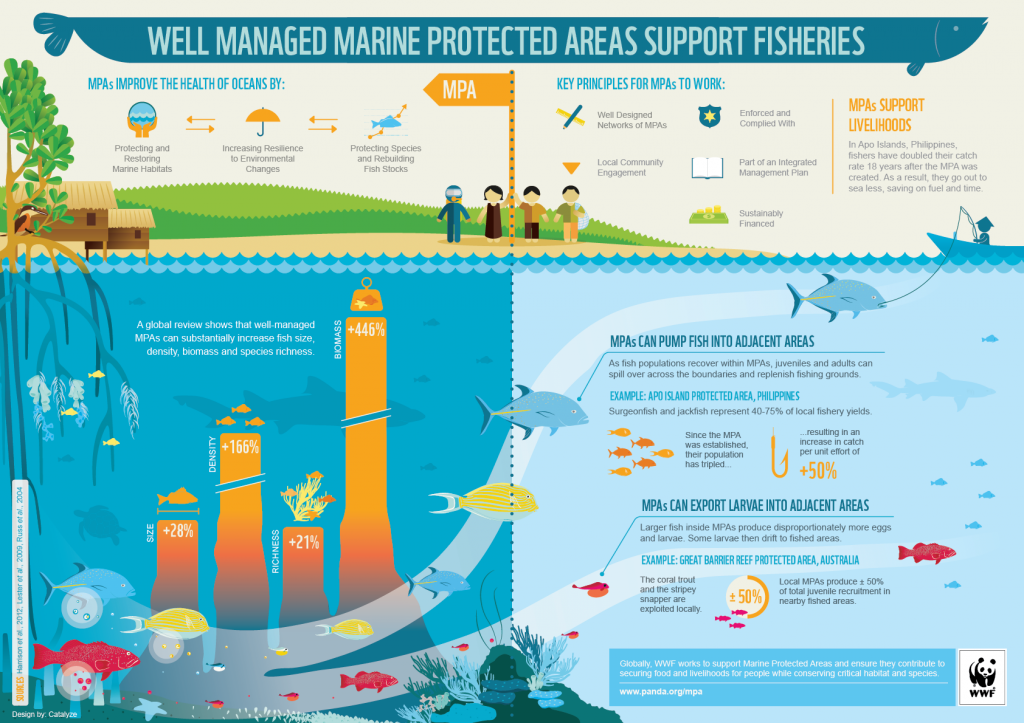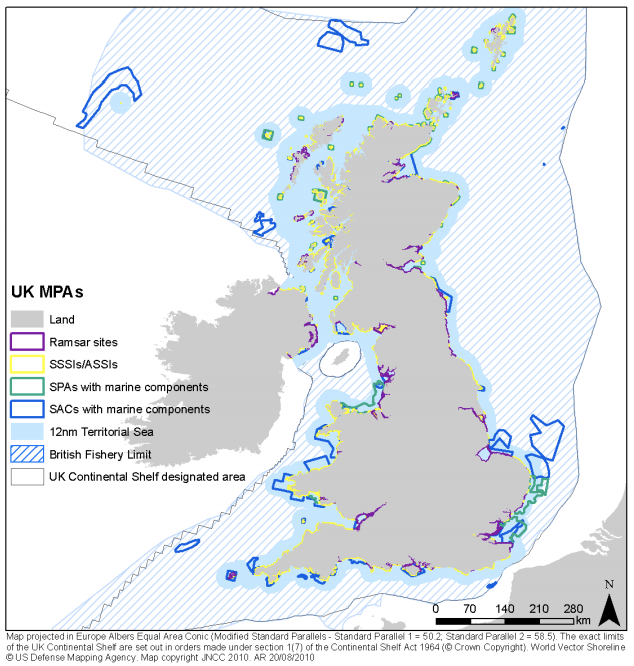The ocean is inexhaustible. This line of thinking was widely accepted in the past. Thankfully we now know that it is indeed the opposite. Every resource is finite and the ocean is no special case. This is the underlying reason why Marine Protected Areas are vitally important to the conservation of our oceans. Marine Protected Areas (MPAs) are protected areas in seas, oceans or lakes which restrict human activity for the purpose of long-term conservation to protect natural or cultural resources. There can be many reasons to create MPAs including for socio-economic, ecological and cultural benefits.
To create an effective MPA, a team of researchers led by Graham J. Edgar discovered five key factors correlated in an MPA’s success. These components include: size, age, proximity, level of enforcement and degree of protection. Considering these factors, there are many reasons why a lot of MPAs are not currently reaching their full potential.
- SIZE
The larger the MPA the greater success it will have, as more individuals and habitats are under protection. The median area of MPAs in the world is only 5km2 whereas a large MPA is considered to be greater than 100km2.
- AGE
Further studies have proved age to be a factor, showing the older the MPA is the more effective it is. MPAs protected for a decade have allowed populations of large predators to build.
- PROXIMITY
MPAs that are in relatively close proximity to civilization with high tourism tend to develop ecologically sensitive problems and the resource people come to visit eventually gets destroyed. Furthermore, having an MPA that isn’t remote will have larger amounts of illegal harvesting and detrimental legal harvesting and therefore often fail. On the other hand, a very remote MPA will make it difficult for scientists to travel there to study the biodiversity and dynamics of the area.
When placing an MPA, the more connectivity and distance to other MPAs, the higher genetic diversity, higher biodiversity and therefore the healthier the ecosystem. A study was completed showing that 70% of species have dispersal rates of less than 50km/yr, however the distances between MPAs are mostly much larger than 50km. As dispersal is a critical factor for the success of MPAs, they need to be closer together.
A large issue is protected areas are placed in areas where they won’t be an inconvenience. In reality, yes the protected area may cause hardships in regions with massive fishing industries. However, in the long-run creating sustainable fisheries is much more important in the grand scheme of things.
- LEVEL OF ENFORCEMENT
In order for MPAs to be effective there needs to be strict and adaptive management. A study showed that if there are high MPA enforcement, management plans present, representatives for fishermen on the MPA board and the promotion of sustainable fishing, then fish stocks were healthier and fishermen incomes are higher. Another study showed that high enforcement led to an increase in fish density/biomass within the MPA, which then increased economic benefits as there were an increased abundance of fish on the outskirts of the boundary.
- DEGREE OF PROTECTION
Each MPA is unique. Therefore, the level of protection for the MPA differs case to case to provide the best course of action for each species at risk. In the UK there are five types of MPAs including:
● Special Areas of Conservation (SACs)
● Special Protection Areas (SPAs)
● Sites of Special Scientific Interest (SSSIs)
● Ramsar sites
● Marine Nature Reserves (MNRs)
A worldwide goal, made a decade ago by the U.N, is to have 10% of the global ocean protected by 2020. Researchers have discovered that so far a mere 3.7% is fully protected as MPAs. We’re not even halfway and there are less than 2 years to reach that 10%. But it must be the right 10%. Protecting 1% off a populated Blackpool, England for example will not be the same as protecting 1% off the small seaside town of New Quay, Wales.
Now these numbers are pretty miserable. And sometimes to be honest this field of study is a little miserable. The majority of news articles surrounding the ocean and the species within them are negative. With all the doom and gloom out there, it is easy to reach your personal empathy saturation. Sometimes you have to remind yourself that there is so much good effort going on in our world. So, to shine the light on some success we’ve had with Marine Protected Areas around the world, here’s some things to be happy about:
● Here at Cardigan Bay, West Wales, UK, there are now two Special Areas of Conservation (SACs). These areas were created with help of past bottlenose dolphin sightings and subsequent research determining dolphin hotspots done by the Sea Watch Foundation.
● Multiple countries came together to create one of the world’s largest Marine Protected Area (MPA) in Antarctica’s Ross Sea.
● The World Wide Fund for Nature discovered with proper creation and management of MPAs, poverty and food insecurity is reduced and employment increased.
● An Italian MPA has 15x more eggs and larvae being produced within the Torre Guaceto Protected Area by large-sized spawners compared to outside the MPA.
● 9,000 year-old glass sponge reefs protected as of February 2017 off the West Coast of Canada in British Columbia
● Farmers surrounding the Great Barrier Reef are taking steps to develop new farming methods to reduce the runoff from farms to protect the reefs
● 1.1 million square kilometers conserved in the Cook Islands Marine Park protecting rare seabirds, manta rays, beaked whales and threatened shark species
Check out the atlas of Marine Protection for most accurate and widely accepted tally of all MPAs showing an interactive map and descriptions of each MPA.
So the question you should be asking yourself after reading this blog is: What can I do? Adapt the “One Health” movement to your life. The health of humans depends on the health of organisms which depends on their ecosystem. If you spend your time out on the water, figure out where the Marine Protected Areas are and what their regulations. Volunteer for an organization dedicated in creating, protecting and/or managing an MPA. Spread the word about the knowledge you’ve gathered to your fellow sea-goers and be a leader in following the regulations so our oceans will continue to be biodiverse and beautiful.
To create an effective MPA, a team of researchers led by Graham J. Edgar discovered five key factors correlated in an MPA’s success. These components include: size, age, proximity, level of enforcement and degree of protection. Considering these factors, there are many reasons why a lot of MPAs are not currently reaching their full potential.
Written by Bridget John




























